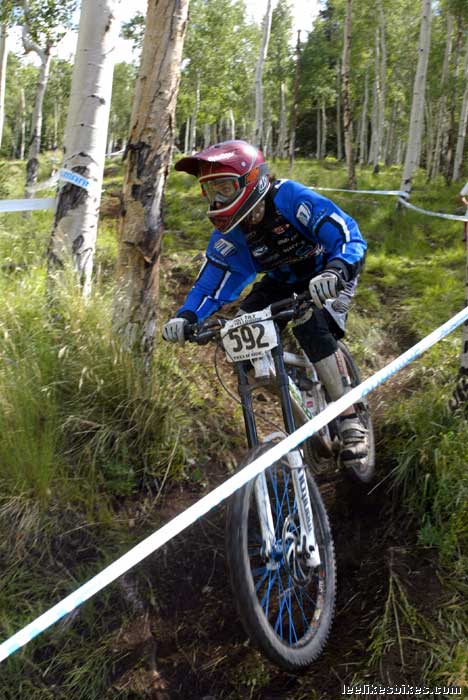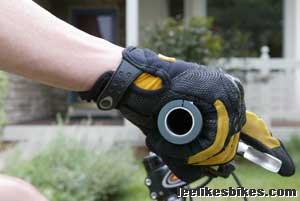Downieville hand syndrome
Hey Lee
Got a question for you. A few weeks ago I headed to Downieville to do a couple runs that were gnarly! I usually brake with my index fingers, but this time I felt like I had no control over my fingers and hands going on such a high speed single track. I usually do downhill runs, but is it the duration and harshness of the trail that cause the loss of function of my hands and fingers? How can I work on this, and is it only me?
Gabe
 Ride like Lisa. This is some gnarly business, but Lisa Myklak’s arms and hands are relaxed. The key: staying low and riding on your pedals. |
Hey Gabe.
Good news!
1. You are not alone. Many people experience this affliction, most commonly associated with long, pinner downhills. Test groups in Whistler have demonstrated similar symptoms.
2. There is a cure (or at least a treatment).
I have left Downieville with blistered, bloody hunks of pulp attached to my wrists. Like you say, those trails are super long and physical — a fast rider takes 45 minutes; most riders take way over an hour. There aren’t many places to practice that sort of thing.
Here are the two main ways to alleviate the symptoms:
Technique
I know, I always say this — but it’s true! I guarantee you’re holding on too tightly, that your weight is too far forward or back, and you’re using your brakes way too much. In brief:
Holding on: Don’t. Find your feet. No matter what happens, drive your weight into your pedals. Loosen your grip and let your bars go where they like.
Braking: Those levers are NOT a dimmer switch, to be dragged from 8,000 feet all the way down to 3,000 feet. Flip ’em on to slow way down (make sure the force is in your feet, not you hands)), then flip ’em off and coast for a while. Be sure to relax while you’re coasting. That lets the blood circulate through your forearm muscles, which prevents arm pump.
Brake setup
 Ride like Brian. Yes, that’s Lopes’ hand. I’ll bet he gets a few thousand dollars for this. |
Position your brake levers so …
… your index finger rests on the end of your lever. This gives you max leverage. Most people have to move their levers in quite a bit. NOTE: You will have to switch your shifter to the outside of the brake lever. I do.
… when you are braking hard and your body is down and back, you can draw a straight line through your forearm, wrist and finger. Many riders have their levers too low — when they brake they have to reach down, which adds lots of stress.
ALSO: Wear fresh gloves that fit snugly across your palm.
If you really mean business, attach handlebars to a paint shaker, then hang on for an hour a day, every day for a month. Pop the blisters, then go hit it!
Also see: Callus management tip #1A
